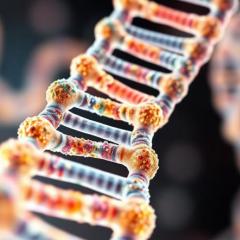Scientists from The University of Queensland’s Diamantina Institute (UQDI) and Institute for Molecular Bioscience (IMB) have identified three new genes behind Jeune Syndrome, a devastating inherited disease in which severe bone deformities lead to profound breathing difficulties and usually early death.
The discoveries will enhance genetic counselling for this disease and may ultimately help improve treatments.
Ms Aideen McInerney-Leo, a PhD student under the supervision of Associate Professor Emma Duncan from the UQ Diamantina Institute, analysed the genetic code of individuals with Jeune syndrome and found that the genes WDR34, WDR60 and IFT172 were mutated in different individuals.
Associate Professor Carol Wicking and Mr Claudio Cortes, PhD student, at the IMB then examined how the genetic mutations caused the disease.
Babies with Jeune syndrome are born with short arms and legs and a very small ribcage, which restricts their lung development and impairs their breathing.
Most sufferers die of respiratory failure soon after birth, while those that survive often face multiple surgical procedures and may also have kidney and liver problems in addition to their breathing and skeletal abnormalities.
The UQ Centre for Clinical Genomics at UQDI, led by Professor Matthew Brown, has pioneered this type of gene discovery, with multiple genes already discovered for a range of devastating skeletal disorders.
Associate Professor Duncan said the methods developed and used at UQDI in these studies are applicable across a range of genetic diseases.
“In the case of Jeune syndrome, these techniques have allowed us to identify several new genes for this disease.
“In the most recent paper we found that WDR34, a gene we didn’t previously know much about, is actually essential for normal development and survival and is the second-most common cause of Jeune Syndrome.”
In all cases analysed so far, the responsible genes have been shown to affect the function of a small hair-like structure projecting from the surface of cells known as the primary cilium.
A/Prof Duncan adds “It was great to have a world leader in cilia research literally on our doorstep to work out the functional significance of our genetics findings.”
A/Prof Wicking highlighted the significance of these discoveries for the affected families.
“Identifying genes that cause Jeune Syndrome means improved genetic counselling for families affected by this disease,” A/Prof Wicking said.
“Pinpointing the genes responsible will also direct further research and offers hope for future treatment of features associated with this disease and the broader class of disorders, known as ciliopathies, to which Jeune syndrome belongs.”
The team collaborated with Dr Hannah Mitchison, Dr Miriam Schmidts and Professor Philip Beales from University College London, and other national and international colleagues, to jointly publish their most recent findings in the prestigious American Journal of Human Genetics. This is their third ciliopathy publication in this journal in the last 12 months.
The researchers thanked the families and physicians who participated in the study, which included patients from around the world.
They also thanked the Australian Cancer Research Foundation, who separately provided funding for two facilities used in the study: the ACRF Dynamic Imaging Facility for Cancer Biology at IMB and specialised equipment for the UQ Centre for Clinical Genomics.



